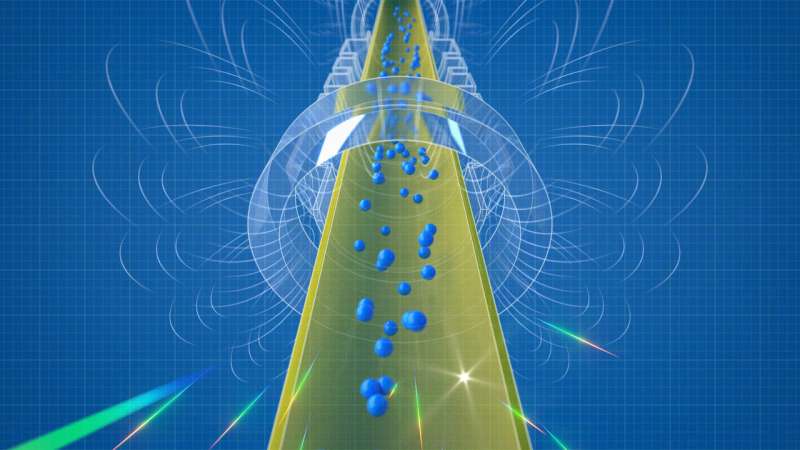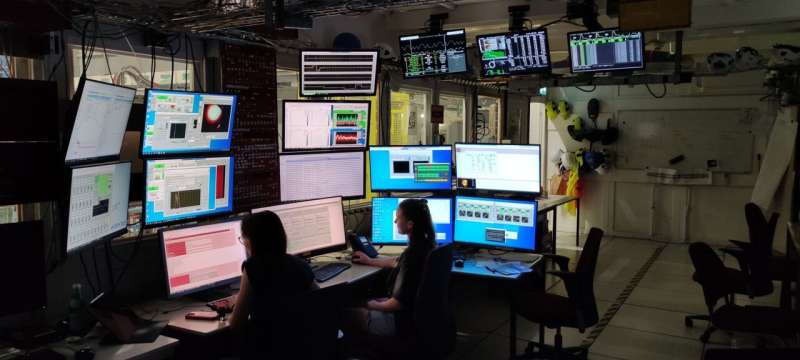This article has been reviewed according to Science X's editorial process and policies. Editors have highlighted the following attributes while ensuring the content's credibility:
fact-checked
peer-reviewed publication
trusted source
proofread
Antimatter embraces Earth, falling downward like normal matter: Study reveals gravity's effect on matter's elusive twin

For those still holding out hope that antimatter levitates rather than falls in a gravitational field, like normal matter, the results of a new experiment are a dose of cold reality.
Physicists studying antihydrogen—an anti-proton paired with an antielectron, or positron—have conclusively shown that gravity pulls it downward and does not push it upward.
At least for antimatter, antigravity doesn't exist.
The experimental results have been reported in the Sept. 28 issue of the journal Nature by a team representing the Antihydrogen Laser Physics Apparatus (ALPHA) collaboration at the European Center for Nuclear Research (CERN) in Geneva, Switzerland.
The gravitational acceleration of antimatter that the team comes up with is close to that for normal matter on Earth: 1 g, or 9.8 meters per second per second (32 feet per second per second). More precisely, it was found to be within about 25% (one standard deviation) of normal gravity.
"It surely accelerates downwards, and it's within about one standard deviation of accelerating at the normal rate," said Joel Fajans, a UC Berkeley professor of physics who, with colleague Jonathan Wurtele, a theoretician, first proposed the experiment more than a decade ago. "The bottom line is that there's no free lunch, and we're not going to be able to levitate using antimatter."
The result will not surprise most physicists. Albert Einstein's theory of general relativity, though conceived before antimatter was discovered in 1932, treats all matter identically, implying that antimatter and matter respond the same to gravitational forces. All normal matter, such as protons, neutrons and electrons, have anti-particles that bear the opposite electrical charge and, when they encounter their normal matter counterpart, annihilate completely.
"The opposite result would have had big implications; it would be inconsistent with the weak equivalence principle of Einstein's general theory of relativity," said Wurtele, UC Berkeley professor of physics. "This experiment is the first time that a direct measurement of the force of gravity on neutral antimatter has been made. It's another step in developing the field of neutral antimatter science."
Fajans noted that no physical theory actually predicts that gravity should be repulsive for antimatter. Some physicists claim that, if it were, you could create a perpetual motion machine, which is theoretically impossible.
Nevertheless, the idea that antimatter and matter might be affected differently by gravity was enticing because it could potentially explain some cosmic conundrums. For example, it could have led to the spatial separation of matter and antimatter in the early universe, explaining why we see only a small amount of antimatter in the universe around us. Most theories predict that equal amounts of matter and antimatter should have been produced during the Big Bang that birthed the universe.
Gravity is incredibly weak
According to Fajans, there have been many experiments, all indirect, that strongly suggest that antimatter gravitates normally, but these experiments have been relatively subtle.
"You might ask, why not do the obvious experiment and drop a piece of antimatter, a sort of leaning tower of Pisa experiment? You know, the experiment that Galileo didn't actually do—it was apocryphal—where he supposedly dropped a lead ball and a wooden ball from the top of the tower and proved that they both reached the ground at the same time," he said.
"The real problem is that the gravitational force is incredibly weak compared to electrical forces," Fajans added. "So far, it has proved impossible to directly measure gravity with a drop-style measurement with a charged particle, like a bare positron, because any stray electric field will deflect the particle much more than gravity will."
In fact, the gravitational force is the weakest of the four known forces of nature. It dominates the evolution of the universe because all matter—theoretically—is affected by it over immense distances. But for a tiny piece of antimatter, the effect is minuscule. A 1 volt/meter electrical field exerts a force on an antiproton that is about 40 trillion times larger than the force of gravity exerted on it by planet Earth.
The ALPHA collaboration at CERN suggested to Wurtele a new approach. By 2010, the ALPHA team was trapping significant quantities of antihydrogen atoms, and in 2011, Wurtele insisted to Fajans that since antihydrogen is charge neutral, it would not be affected by electric fields, and they should explore the possibility of a gravity measurement.
Fajans dismissed the idea for many months, but was eventually persuaded to take it seriously enough to perform some simulations that suggested Wurtele's ideas had merit. UC Berkeley lecturer Andrew Charman and postdoctoral fellow Andrey Zhmoginov became involved and realized that a retrospective analysis of prior data could provide very coarse limits on antimatter's gravitational interactions with Earth.
With help from their ALPHA colleagues, this led to a paper that concluded that antihydrogen experiences no more than about 100 times the acceleration—in the up or down direction—due to Earth's gravity, compared to regular matter.
That underwhelming start nevertheless convinced the ALPHA team to build an experiment to make a more precise measurement. In 2016 the collaboration began to construct a new experiment, ALPHA-g, which conducted its first measurements in the summer and fall of 2022.
The results published in Nature are based on simulations and a statistical analysis of what the team observed last year and puts the gravitational constant for antimatter at 0.75 ± 0.13 ± 0.16 g, or, if you combine the statistical and systematic errors, 0.75 ± 0.29 g, which is within error bars of 1 g. The team concluded that the chance of gravity being repulsive for antimatter is so small as to be meaningless.

At least a dozen UC Berkeley undergraduate physics majors participated in the assembly and running of the experiment, Fajans and Wurtele said, many of them from groups not well represented in the field of physics.
"It's been a great opportunity for many Berkeley undergraduates," Fajans said. "They're fun experiments, and our students learn a lot."
A balance
The plan for ALPHA-g that Wurtele and Fajans proposed was to confine about 100 antihydrogen atoms at a time in a 25-centimeter-long magnetic bottle. ALPHA can only confine antihydrogen atoms that have a temperature less than half a degree above absolute zero, or 0.5 Kelvin.
Even at this extremely low temperature, the antiatoms are moving at speeds averaging 100 meters per second, bouncing hundreds of times per second off the strong magnetic fields at the ends of the bottle. (The magnetic dipole moment of an antihydrogen atom is repelled by the pinched 10,000 Gauss magnetic fields at each end of the bottle.)
If the bottle is oriented vertically, the atoms moving downward will accelerate due to gravity, while those moving upward will decelerate. When the magnetic fields at each end are identical, that is, balanced, those atoms moving downward will have, on average, more energy. Thus, they will be more likely to escape through the magnetic mirror and hit the container, annihilating in a flash of light and producing three to five pions. The pions are detected to determine whether the antiatom escaped upward or downward.
The experiment is like a standard balance used to compare very similar weights, Fajans said. The magnetic balance makes the relatively tiny gravitational force visible in the presence of much larger magnetic forces, much the same way that a normal balance makes visible the difference between 1 kilogram and 1.001 kilograms.
The mirror magnetic fields are then very slowly ramped down, so that all the atoms eventually escape. If antimatter behaves like normal matter, more antiatoms—about 80% of them—should escape out the bottom than the top.
"The balancing allows us to ignore the fact that the antiatoms are all of different energies," Fajans said. "The lowest energy ones escape last, but they're still subject to the balance, and the effect of gravity is enhanced for all antiatoms."
The experimental setup also allows ALPHA to make the bottom magnetic mirror stronger or weaker than the top mirror, which gives each antiatom a boost in energy that can cancel or overcome the effects of gravity, allowing equal or greater numbers of antiatoms to go out the top than the bottom.
"This gives us a powerful experimental knob that allows us, basically, to believe the experiment actually worked because we can prove to ourselves that we can control the experiment in a predictable manner," Fajans said.
The results had to be treated statistically because of the many unknowns: The researchers couldn't be certain how many antihydrogen atoms they'd trapped, they couldn't be sure they detected every annihilation, they couldn't be sure there were not some unknown magnetic fields that would have affected the antiatom trajectories, and they couldn't be sure they'd measured the magnetic field in the bottle correctly.
"ALPHA's computer code simulating the experiment could be subtly wrong because we don't know the precise initial conditions of the antihydrogen atoms, it could be wrong because our magnetic fields aren't correct, and it could be wrong for some unknown unknown," Wurtele said. "Nonetheless, the control provided by adjusting the balance knob lets us explore the extent of any discrepancies, giving us confidence that our result is correct."
The UC Berkeley physicists are hopeful that upcoming improvements to ALPHA-g and to the computer codes will improve the instrument's sensitivity by a factor of 100.
"This result is a group effort, although the genesis of this project was at Berkeley," Fajans said, "ALPHA was designed for spectroscopy of antihydrogen, not gravitational measurements of these antiatoms. Jonathan's and my proposal was completely orthogonal to all the plans for ALPHA, and the research would likely not have happened without our work and years of lonely development."
And while the null result could be dismissed as unexciting, the experiment is also an important test of general relativity, which to date has passed all other tests.
"If you walk down the halls of this department and ask the physicists, they would all say that this result is not the least bit surprising. That's the reality," Wurtele said. "But most of them will also say that the experiment had to be done because you never can be sure. Physics is an experimental science. You don't want to be the kind of stupid that you don't do an experiment that explores possibly new physics because you thought you knew the answer, and then it ends up being something different."
Undergraduate students who participated include Josh Clover, Haley Calderon, Mike Davis, Jason Dones, Huws Landsberger, Nicolas Kalem James McGrievy, Dalila Robledo, Sara Saib, Shawn Shin, Ethan Ward, Larry Zhao and Dana Zimmer.
More information: Jeffrey Hangst, Observation of the effect of gravity on the motion of antimatter, Nature (2023). DOI: 10.1038/s41586-023-06527-1. www.nature.com/articles/s41586-023-06527-1
Anna Soter, Free-falling antihydrogen reveals the effect of gravity on antimatter, Nature (2023). DOI: 10.1038/d41586-023-02930-w , www.nature.com/articles/d41586-023-02930-w
Journal information: Nature
Provided by University of California - Berkeley





















